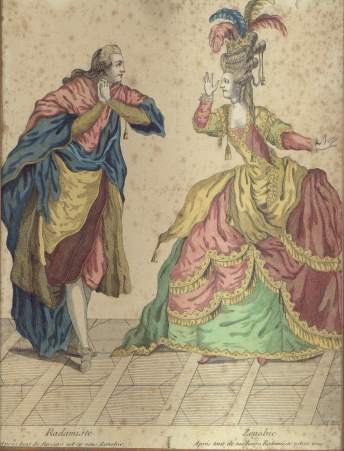| Emerging
Acting Styles around Voltaire
- page 1/5 |
11/2001 |
LEIDEN
September 2001

City of Leiden
Académie Desprez - University of Leiden - Leidse Schouwburg
The Leiden Theatre
Perspective 1705-2005
International Symposium 2001
Eighteenth Century European Acting
Styles
ACADEMIE
DESPREZ
Gilbert Blin
Rémy-Michel Trotier
Olivier Till – Philippe Rolland
Emerging
Acting Styles around Voltaire
Workshop – Lecture – Video projection –
Demonstration
Olivier
Till’s research on costumes
supported by the LEKAIN
travel grant (in  )
of the Académie Desprez )
of the Académie Desprez
Philippe
Rolland’s research on Voltaire & Desprez
supported by the BRUNETTI
study grant of the Académie
Desprez
Rémy-Michel
Trotier’s research on French declamation
supported by the BACILLY
study grant of the Académie
Desprez
The
Académie Desprez extends heartfelt thanks to the
Ambassade de France aux Pays-Bas
Emerging
Acting Styles around Voltaire
Every important European
theatre of the XVIIIth century welcomed French spoken
theatre performances. Voltaire’s Sémiramis and Zaïre
were performed in Drottningholm, whilst his Tancrède
and Mahomet appeared in Leiden; Olympie was
presented in both places.
Voltaire was an important
author in Leiden theatre life at that time; in 1774, of the five
evenings which brought in the highest income of the season, four
included plays by Voltaire. And not only Dutch actors, but also
French companies came to present his works – performed in
French, according to a custom which would continue with Talma.
Very naturally studying
Voltaire is one important possible step in the celebration of
Leiden’s theatre. But in order to understand -and maybe
reconstruct- the conditions of performance at the time, it is
necessary to turn again to Drottningholm: the only working XVIIIth
century theatre extant today. The place, as it is, enables us to
discover all the elements of theatrical practice, as they were.
This is the programme the Académie Desprez refers to, when
undertaking reconstruction connected to the Age of Enlightment.
Exploring the life of
Voltaire's favourite actor makes the programme richer than ever;
Gustave III, when travelling to Paris, saw Lekain on stage in
1771 performing Néron in Britannicus; after that, the
professional performer and the royal actor kept on interpreting
the same parts: Rhadamiste in the tragedy of Crébillon, Bayard
in Belloy’s Gaston & Bayard and Voltaire’s
Gengis Khan in L’Orphelin de la Chine. And Gustave
III’s favorite architect, Louis-Jean Desprez, painted
tremendous visions of Lekain as Ninias in Sémiramis.
In response to Dr Cobi
Bordewijk’s invitation, members of the Académie Desprez
present a lecture about Lekain, and a workshop to experiment
with the reforms in acting styles at his time. A video
projec-tion shows a contextual example of a performance in
Drottningholms Slottsteater. Finally, the workshop opens its
doors to the participants in the Second International Symposium
of the Leiden Theatre Perspective.
Workshop
|
